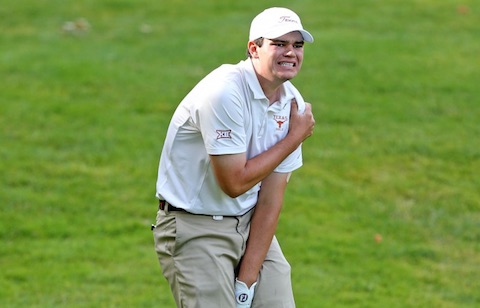
Beau Hossler of Texas grabs his shoulder in pain after hitting a shot at No. 17
(Golfweek/Tracy Wilcox)
EUGENE, OREGON (May 31, 2016) -- It was the most
amazing match play finish I've ever seen.
Playing against Andrew Levitt of USC, Beau Hossler
fought back from 2-down only to injure his shoulder
on
the par-5 15th hole while going for the green in two.
The pain got so bad that he buckled over
immediately after hitting his tee shot on the par-3
16th. If you only saw the swing, you would never
believe his ball would get airborne, let alone clear
the
water and land safely on the other side of the
difficult
hole.
Somehow, Hossler managed to concentrate on his
chip
shot, strike it perfectly and hole it to go 2-up. But
after
hitting his tee shot on No. 17 and once again
buckling
over, it appeared he wouldn't be able to go on.
But quitting isn't part of Hossler's DNA, he was going
to
give it his best shot.
"Obviouly, I didn't want to hurt myself," Hossler told
Steve Burkowski of The Golf Channel, when asked if
he
thought about not finishing the match. "But at the
same time this is a national championship - this is
the
goal that I had the first day I stepped on campus at
Texas ... sometimes you've got to sacrifice a little bit
to
do that."
This is where it got pretty amazing. One more
painful
shot from the right rough later, and Hossler found
himself in the right hand greenside bunker, with an
uphill lie and not much green to work with. A
straightforward bunker shot for a Division I college
player, but not in the shape he was in physically.
So he pulled out the putter, rolled it safely out (but
twenty feet past) and holed a 20 foot, left-to-right
downhill putt for the win.
Whether he plays tomorrow is a mystery. Should he
have time to nurse the shoulder sufficiently, it's still
going to be tough to put the thought of it flaring up
on
a swing out of his mind. We certainly wish him the
best.
Texas ended up not needing Hossler's point, but he
would have had no way to know it at the time. They
beat USC 4-1.
In the other semifinal match, Oregon defeated No. 2
Illinois, with big wins by Edwin Yi and Zack Foushee
(he was on fire against Nick Hardy, winning 5&3) and
a
close 1-up victory by Sulman Raza over Charlie
Danielson.
FINAL ROUND PAIRINGS
As for the pairings against Oregon, they were made
by
the captains with both teams present to put their
names up after their pick. Oregon coach Casey
Martin,
chose to avoid pairing his No. 1 player (and
individual
champ) against Hossler. That way if Hossler is
unable
to play he isn't using him in a match that is won by
default.
Following are the pairings for Wednesday's final
match, which starts at 5:00pm EDT/2:00pm PDT. You
can watch live on The Golf Channel at
6:00pm/3:00pm. Don't miss it!
MATCH 1Edwin Yi of Oregon vs. Gavin
Hall of Texas
MATCH 2Aaron Wise of Oregon vs.
Scottie Scheffler of Texas
MATCH 3Zack Foushee of Oregon vs.
Beau Hossler of Texas
MATCH 4Sulman Raza of Oregon vs.
Taylor Funk of Texas
MATCH 5Thomas Lim of Oregon vs.
Doug Ghim of Texas
ABOUT THE
NCAA Division I Championship
The NCAA Division I Men’s Golf Championship is the pinnacle of collegiate golf in the United States, held annually in late May or early June. The event brings together the nation's top 30 teams and six individual qualifiers, all of whom have advanced through a grueling regional qualifying process. Conference champions earn automatic regional berths, while a selection committee fills the remaining spots.
The championship begins with 72 holes of stroke play to determine the individual national champion. Following this, the top 8 teams advance to a match play bracket to compete for the team title — a format introduced in 2009 that added a dramatic head-to-head element to the final days of competition.
Some of the most decorated names in professional golf have competed in this event, including Jack Nicklaus, Hale Irwin, Tiger Woods, and Phil Mickelson. Winning the individual title now includes an added bonus: the champion receives an invitation to the following year’s Masters Tournament, provided they maintain amateur status.
The tournament dates back to 1897, originally run by the National Intercollegiate Golf Association. The NCAA began officially sponsoring the event in 1939. Over time, the championship has become not just a collegiate milestone, but also a launching pad for future PGA Tour stars.
After 72 holes of stroke play, the individual champion is crowned, and the low 8 teams advance to match play to determine the team champion.
View Complete Tournament Information